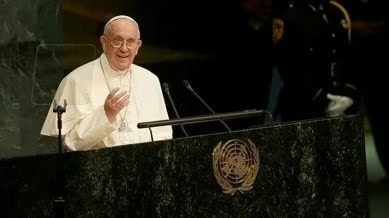
Pope Francis

23.04.2025
Pope Francis
|
For Prelims: About the Pope Francis |
Why in the news?
Pope Francis, leader of the Roman Catholic Church has passed away and India has announced a three-day state mourning, as a mark of respect.
About the Pope Francis:
- Pope Francis was the 266th pope, in a lineage dating back to Saint Peter in 30 CE.
- He assumed the papacy in 2013, taking over from Pope Benedict XVI.
- Pope Francis was the first non-European pope in more than a millennium and the first Latin American pope.
Office of Pope
- In Christianity, there are three major branches — Catholic, Protestant, and (Eastern) Orthodox.
- And among them, the Pope is the supreme spiritual leader of Roman Catholics.
- The papacy oversees the Holy See, the central governing body of the Church and Vatican City.
- The Ring of the Fisherman, the Pope’s signet ring bearing the seal of his papacy, is broken off to symbolise the end of his rule.
Election of Pope:
-
- The College of Cardinals, the Church’s most senior officials worldwide, chooses the pope.
- Within 15-20 days, cardinals under age 80 arrive from all over the world to participate in the papal conclave, the secret election process to determine a successor.
- A candidate must receive a two-thirds majority of votes to be elected.
- In India, four cardinals are eligible to vote in a papal conclave.
Source: Indian Express
Consider the following statement regarding to the Pope Francis:
Statement-I: Pope Francis, leader of the German Catholic Church.
Statement-II: Pope Francis was the first non-European pope in more than a millennium and the first Latin American pope.
Which one of the following is correct in respect of the above statements?
A.Both Statement-I and Statement-II are correct, and Statement-II is the correct explanation for Statement-I.
B.Both Statement-I and Statement-II are correct, and Statement-II is not the correct explanation for Statement-I.
C.Statement-I is correct, but Statement-II is incorrect.
D.Statement-I is incorrect, but Statement-II is correct.
Answer D